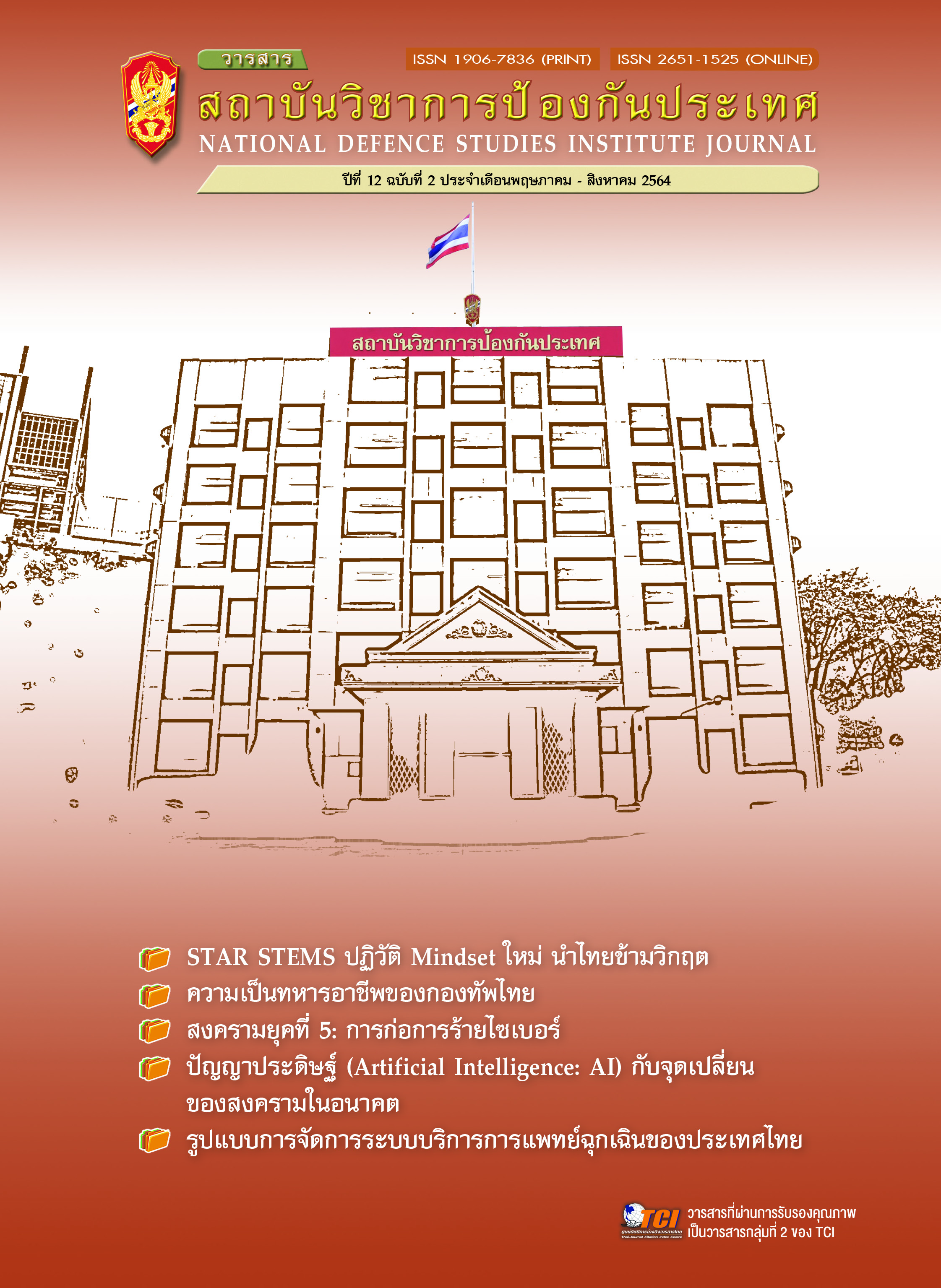Study of Mathematical Achievement Analytical Thinking Skills and Problem Solving Skills of the Second-Year Pre-Cadets by Learning Management According to the 7-Stage Learning Cycle (7E) and The SSCS Model
Main Article Content
Abstract
The purposes of the research are 1) to study mathematical achievement in Calculus, 2) to study analytical thinking skills, 3) to study problem solving skills, and 4) to study satisfaction of the second-year pre-cadets towards learning management according to the 7-stage learning cycle (7E) and the SSCS model. The research methodology is quasi-experimental research with the use of one group pretest-posttest design method. The research was carried out in the second semester of the academic year 2020 at the Armed Forces Academies Preparatory School, National Defence Studies Institute, Royal Thai Armed Forces Headquarters. The participants are 66 second-year pre-cadets sampled by using cluster sampling. The research instruments are 1) mathematical achievement test of Calculus, which consist of 40 items divided into 30 multiplechoice questions for the analytical thinking skills test and 10 subjective questions for problem solving skills test, 2) Calculus learning management plan according to the 7-stage learning cycle (7E) and the SSCS model, which consists of 17 plans., and 3) a satisfaction questionnaire towards learning management based on the 7-stage learning cycle (7E) and the SSCS model, which is a five-level scale questionnaire of 18 items. The data were analyzed to find the mean, standard deviation, percentage, and T-test for comparing mathematical achievement before and after learning (Paired-Samples T-test) and comparing the achievement with the specified criteria (One-Sample T-test).
The research findings show that the mathematical achievement on Calculus of the second-year pre-cadets after engaging in learning management according to the 7-stage learning cycle (7E) and the SSCS model is higher than before with statistical significance at the 0.05 level and the mathematical achievement pass the specified criteria, which is not lower than 75 percent with statistical significance at the 0.05 level. The analytical thinking skills and the problem solving skills of the second-year pre-cadets who have engaged in learning management according to the 7-stage learning cycle (7E) and the SSCS model pass the specified criteria, which is not lower than 75 percent with statistical significance at the .05 level. The satisfaction of the second-year pre-cadets towards learning management according to the 7-level learning cycle (7E) and the SSCS model is at a high level.
Article Details

This work is licensed under a Creative Commons Attribution-NonCommercial-NoDerivatives 4.0 International License.
The articles, images, tables, graphs, written content, and opinions published in this journal are solely those of the authors and do not necessarily reflect the views or positions of the National Defence Studies Institute or its academic affiliates.
References
กระทรวงศึกษาธิการ. (2560). หลักสูตรการศึกษาขั้นพื้นฐาน พุทธศักราช 2551 (ฉบับปรับปรุง 2560). กรุงเทพ ฯ:โรงพิมพ์คุรุสภาลาดพร้าว.
ดารณี ชมโสม. (2562). การพัฒนากิจกรรมการเรียนรู้วิชาคณิตศาสตร์โดยใช้รูปแบบวัฏจักรการเรียนรู้ (7E) เรื่อง ทศนิยมและเศษส่วน สำหรับนักเรียนชั้นมัธยมศึกษาปีที่ 1. วารสารวิชาการหลักสูตรและการสอนมหาวิทยาลัยราชภัฏสกลนคร, 12(33), 1-12.
นริศรา สำราญวงษ์. (2558). การจัดการเรียนรู้ด้วยรููปแบบ SSCS เพื่อพัฒนาความสามารถในการแก้ปัญหาทางการเรียนคณิตศาสตร์และผลสัมฤทธิ์ทางการเรียนคณิตศาสตร์เรื่องบทประยุกต์ สำหรับนักเรียนชั้นประถมศึกษาปีที่ 5 (วิทยานิพนธ์ศึกษาศาสตรมหาบัณฑิต). มหาวิทยาลัยบูรพา.
เบญจวรรณ ภักดีพงษ์. (2557). ผลการจัดการเรียนรู้แบบ SSCS ที่มีต่อความสามารถในการแก้ปัญหา และผลสัมฤทธิ์วิชาคณิตศาสตร์เรื่องอสมการของนักเรียนชั้นมัธยมศึกษาปีที่ 3 (วิทยานิพนธ์ศึกษาศาสตรมหาบัณฑิต).มหาวิทยาลัยบูรพา.
พิมพันธ์ เดชะคุปต์. (2548). การเรียนการสอนที่่เน้นนักเรียนเป็นศูนย์กลาง. กรุงเทพฯ : เดอะมาสเตอร์กรุ๊ปเมเนจเม็นท์.
ลียานา ประทีปวัฒนพันธ์. (2558). การศึกษาผลสัมฤทธิ์ทางการเรียนคณิตศาสตร์เรื่องความน่าจะเป็นของนักเรียนห้องเรียน สสวท.ชั้นมัธยมศึกษาปีที่ 3 โดยการจัดการเรียนรู้แบบวัฏจักรการเรียนรู้ 7E ร่วมกับการเรียนแบบ STAD (วิทยานิพนธ์วิทยาศาสตรมหาบัณฑิต). มหาวิทยาลัยบูรพา.
วัลลภ รัฐฉัตรานนท์์. (2562). การหาขนาดตัวอย่างที่เหมาะสมสำหรับการวิจัย: มายาคติในการใช้สูตรของ ทาโร ยามาเนและเครจซี-มอร์แกน. วารสารรัฐศาสตร์ปริทรรศน์ มหาวิทยาลัยเกษตรศาสตร์, 6(1), 27-58.
วรรณพร ยิมฉาย. (2559). การศึกษาผลสัมฤทธิ์ทางการเรียนวิชาชีววิทยาและทักษะการคิดวิเคราะห์ เรื่อง ระบบหมุนเวียนเลือด ระบบน้ำเหลืองและระบบภูมิคุ้มกัน ด้วยการจัดการเรียนรู้้ โดยใช้ชุดกิจกรรมการเรียนรู้รููปแบบวัฏจักรการเรียนรู้ 7 ขั้น (7E) สำหรับนักเรียนชั้นมัธยมศึกษาปีที่ 4 (วิทยานิพนธ์ศึกษาศาสตรมหาบัณฑิต).มหาวิทยาลัยบูรพา.
วิภาดา คล้ายนิ่ม และคณะ. (2560). ผลสัมฤทธิ์ทางการเรียนคณิตศาสตร์ของนักเรียนชั้นมัธยมศึกษาปีที่่ 5 เรื่องความน่าจะเป็น โดยใช้รูปแบบ SSCS. วารสารศึกษาศาสตร์ มสธ., 10(2), 329-345.
วิภู มูลวงค์. (2559). การพัฒนาความสามารถในการแก้ปัญหาทางคณิตศาสตร์ของนักเรียนชั้นมัธยมศึกษาปีที่่ 2 ที่จัดการเรียนรู้ โดยใช้กรณีศึกษา (วิทยานิพนธ์ศึกษาศาสตรมหาบัณฑิต). มหาวิทยาลัยศิลปากร.
สันนิสา สมัยอยู่. (2553). ผลการจัดการเรียนรู้แบบ SSCS ที่มีต่อความสามารถในการแก้ปัญหาและการสื่อสารทางคณิตศาสตร์ของนักเรียนชั้นมัธยมศึกษาปีที่่ 2 เรื่องการประยุกต์ของสมการเชิงเส้นตัวแปรเดียว (วิทยานิพนธ์ศึกษาศาสตรมหาบัณฑิต). มหาศรีนครินทรวิโรฒ.
สุคนธ์ สินทพานนท์ และคณะ. (2554). วิธีสอนตามแนวปฏิรูปการศึกษาเพื่อพัฒนาคุณภาพเยาวชน. กรุงเทพฯ:สำนักพิมพ์เทคนิคพริ้นติ้ง.
สุภาภรณ์ ชิดโคกสูง และคณะ. (2560). การศึกษาผลสัมฤทธิ์ทางการเรียนและเจตคติต่อวิชาคณิตศาสตร์ของนักเรียนชั้นประถมศึกษาปีที่ 3 ที่ได้รับการจัดการเรียนรู้แบบวัฏจักรการเรียนรู้ 7E. วารสารวไลยอลงกรณ์ปริทัศน์(มนุษยศาสตร์และสังคมศาสตร์), 7(2), 116-117.
ศศิธร เวียงวะลัย. (2556). การจัดการเรียนรู้ . กรุงเทพฯ: สำนักพิมพ์โอเดียนสโตร์.
สำนักงานเลขาธิการสภาการศึกษา. (2560). แผนการศึกษาแห่งชาติ พ.ศ.2560-2579.
อารฝัน บากา. (2559). การพัฒนาผลสัมฤทธิ์ทางการเรียนและการคิดวิเคราะห์ของนักเรียนชั้นมัธยมศึกษาปีที่ 4 ด้วยการจัดการเรียนรู้แบบวัฏจักรการเรียนรู้ 7 ขั้น ร่วมกับเทคนิคการใช้้คำถามระดับการวิเคราะห์ (วิทยานิพนธ์วิทยาศาสตรมหาบัณฑิต). มหาวิทยาลัยบูรพา


